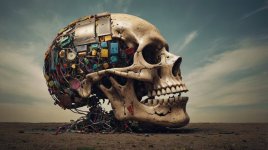Artificial Intelligence (AI) is revolutionizing industries, streamlining processes, and reshaping how work is done. But as it integrates deeper into our professional lives, a provocative question is stirring debate across workplaces: Is AI killing creativity?
At first glance, AI seems like a productivity miracle. It can generate written content in seconds, compose music, design logos, and even suggest business strategies. Tools like ChatGPT, Midjourney, and others are helping teams brainstorm faster and execute ideas at unprecedented speeds. However, this convenience raises an uncomfortable concern — are we becoming too reliant on machines to think for us?
Creativity thrives on struggle, reflection, trial, and error. Yet AI often bypasses these stages, offering polished results with minimal human input. While this sounds efficient, it also risks flattening originality. When everyone uses the same AI tools to brainstorm or generate content, we start seeing homogenized ideas, lacking the depth, emotion, or nuance that true creativity demands. There's a thin line between assistance and replacement — and AI seems to be blurring it.
Moreover, many workplaces are now valuing "efficiency" over "imagination." Instead of asking employees to ideate from scratch, some companies prefer AI-generated prototypes to save time. The danger here is that AI doesn't create — it reconfigures. It draws from existing patterns, data, and inputs. That means it's fundamentally incapable of true innovation. If we increasingly lean on AI to define creative direction, we're limiting ourselves to what's already been done.
However, the other side of the debate argues that AI doesn't kill creativity — it amplifies it. Proponents suggest that AI can take over repetitive tasks, freeing up time and mental bandwidth for humans to explore more ambitious, innovative projects. For example, copywriters can use AI to overcome writer’s block or generate drafts they later personalize. Designers can iterate faster, and marketers can test campaigns more broadly before settling on a final vision.
Still, this utopian view assumes a workforce trained to use AI critically — not passively. The real risk isn’t AI itself, but how we use it. In environments where AI is treated as a collaborator, creativity can indeed flourish. But where it's treated as a replacement, creativity will inevitably wither.
Another concern is that younger professionals may skip the skill-building phase entirely. If AI handles the heavy lifting, are they really learning how to ideate, edit, and iterate? If we fast-track results through AI, we might be raising a generation of workers who can prompt but not create, critique but not construct.
So, is AI killing creativity in the workplace? Not inherently — but it can, if we let it. It depends on whether we use AI to support human insight or to sidestep it. The future of creativity at work lies not in resisting AI, but in redefining the human role — as editors, curators, and visionaries who can shape AI outputs into something truly original.
The debate isn’t about man vs. machine — it’s about balance, responsibility, and intentional use. The question now is: Are we ready to keep creativity alive in the age of automation?
At first glance, AI seems like a productivity miracle. It can generate written content in seconds, compose music, design logos, and even suggest business strategies. Tools like ChatGPT, Midjourney, and others are helping teams brainstorm faster and execute ideas at unprecedented speeds. However, this convenience raises an uncomfortable concern — are we becoming too reliant on machines to think for us?
Creativity thrives on struggle, reflection, trial, and error. Yet AI often bypasses these stages, offering polished results with minimal human input. While this sounds efficient, it also risks flattening originality. When everyone uses the same AI tools to brainstorm or generate content, we start seeing homogenized ideas, lacking the depth, emotion, or nuance that true creativity demands. There's a thin line between assistance and replacement — and AI seems to be blurring it.
Moreover, many workplaces are now valuing "efficiency" over "imagination." Instead of asking employees to ideate from scratch, some companies prefer AI-generated prototypes to save time. The danger here is that AI doesn't create — it reconfigures. It draws from existing patterns, data, and inputs. That means it's fundamentally incapable of true innovation. If we increasingly lean on AI to define creative direction, we're limiting ourselves to what's already been done.
However, the other side of the debate argues that AI doesn't kill creativity — it amplifies it. Proponents suggest that AI can take over repetitive tasks, freeing up time and mental bandwidth for humans to explore more ambitious, innovative projects. For example, copywriters can use AI to overcome writer’s block or generate drafts they later personalize. Designers can iterate faster, and marketers can test campaigns more broadly before settling on a final vision.
Still, this utopian view assumes a workforce trained to use AI critically — not passively. The real risk isn’t AI itself, but how we use it. In environments where AI is treated as a collaborator, creativity can indeed flourish. But where it's treated as a replacement, creativity will inevitably wither.
Another concern is that younger professionals may skip the skill-building phase entirely. If AI handles the heavy lifting, are they really learning how to ideate, edit, and iterate? If we fast-track results through AI, we might be raising a generation of workers who can prompt but not create, critique but not construct.
So, is AI killing creativity in the workplace? Not inherently — but it can, if we let it. It depends on whether we use AI to support human insight or to sidestep it. The future of creativity at work lies not in resisting AI, but in redefining the human role — as editors, curators, and visionaries who can shape AI outputs into something truly original.
The debate isn’t about man vs. machine — it’s about balance, responsibility, and intentional use. The question now is: Are we ready to keep creativity alive in the age of automation?

